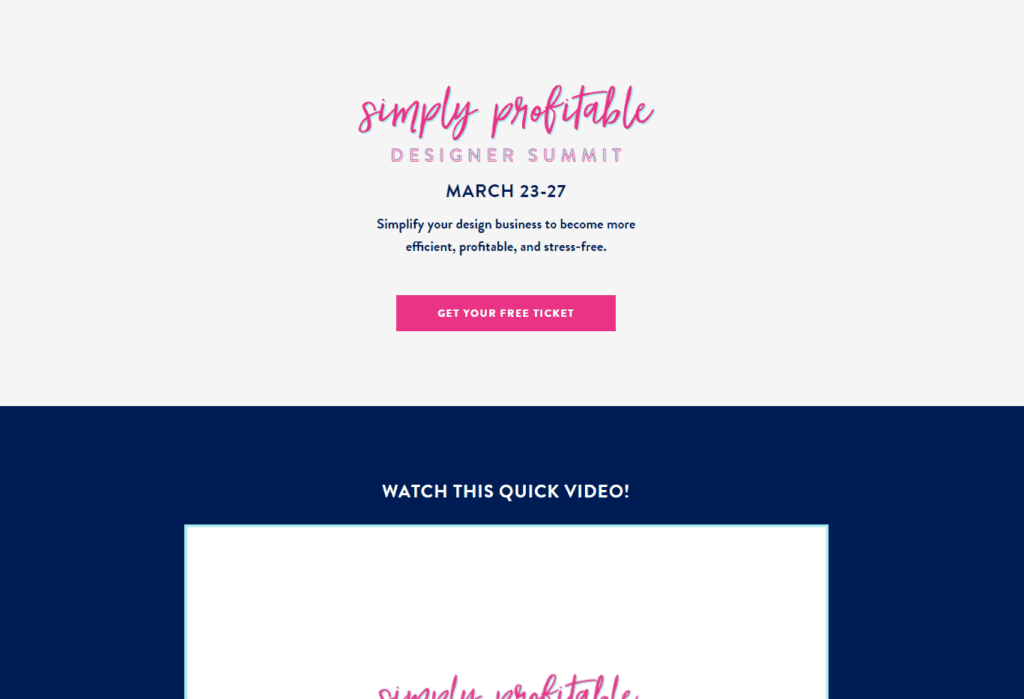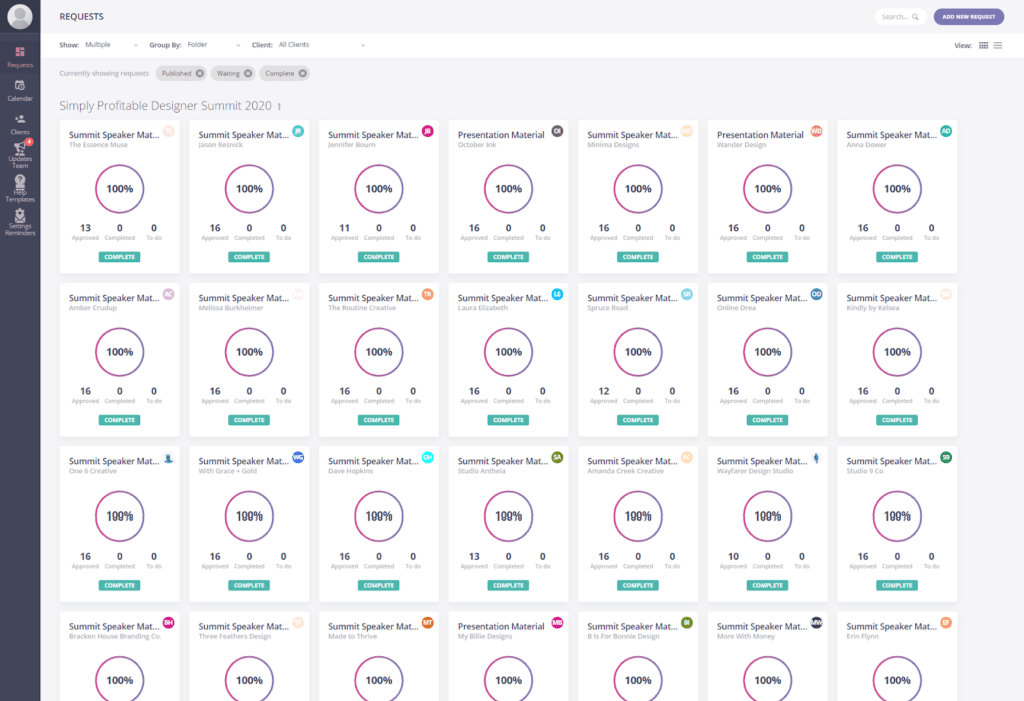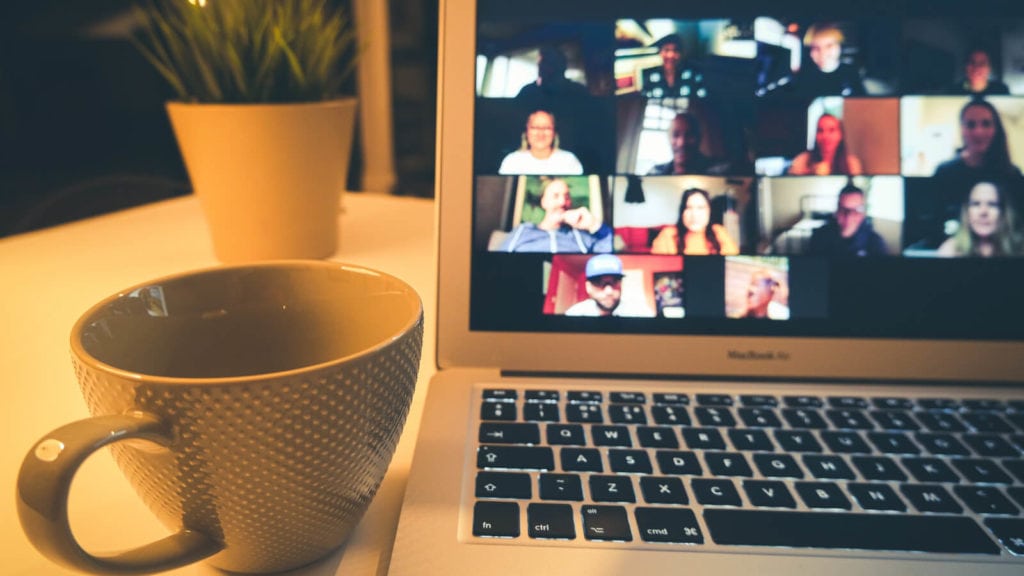You’ve made it to a place in your business where you feel pretty successful. You’ve got the sales you need coming in, your email list grows slowly (but it does the job), and you have a couple of strong connections in your industry. All the initial goals you set when you started your business? Check!
But now what?
If you’re anything like me, you may have hit a point where you feel stuck. You have the clients, course sales, or membership sales you need, but you want more. You have an email list, but want to see it grow. A good number of people know who you are, but you want to be the go-to person in your industry. And you certainly wouldn’t complain about a larger collection of mutually beneficial connections with others who complement your industry.
What if I told you that you could accomplish every one of those goals with a single strategy?
Good news - you can!
Hosting a virtual summit is the only way to do all of that and more. With a virtual summit done correctly, you’ll see:
- Your email list grow to 3x its current size with warm leads
- Your normal monthly revenue skyrocket to 3-4x what you’re used to seeing (or more)
- 20+ connections with industry leaders who you can trade opportunities with for years to come
- Yourself suddenly positioned as the go-to expert in your field
- An engaged audience who can’t wait to see what you do next
It’s totally possible for you!
Before hosting my first summit, I had an unengaged email list of about 500 people. I was booking clients for my WordPress development business as I needed them but was bringing in just above the bare minimum each month. I knew I was one of the best in my industry, but not many others did.

New email subscribers
After hosting my first online summit my email list tripled to 1500, I made $16,000 in sales which was quadruple what I was used to making in a month, I booked out my services for 6 months in advance, and I was suddenly the go-to developer in my industry.
Krista Rae. Summit In A Box
And that was just the beginning! My most recent summit brought in 4000 leads, $59k, and an incredible experience for everyone involved.
If you’re starting small, this may seem out of reach. But if I could do it with my small list and lack of experience you can too and we’ll go over all the basics you need to know about running a virtual summit in this post, including:
- What a virtual summit is
- Common misconceptions
- The 10 stages of hosting your first profitable virtual summit
What is a Virtual Summit?
A virtual summit is much like an in-person conference - only online! The summit host (you!) brings together a group of experts, generally 20-30, to speak about a topic related to their expertise. These online events are generally 3-5 days long and all of the individual topics come together to support the overall theme of the virtual summit to solve one of the target audience’s core problems.
Virtual summits are generally free to attend, which is where the email list growth comes in. This free access allows attendees to view each presentation for 24 hours. Then, once registered, they are presented with an opportunity to purchase a related offer, usually an all-access pass, which is the first opportunity for income. More on that later.
You’ll see a virtual summit referenced with all kinds of different terms. The most common terminology includes:
- Online summit
- Virtual conference
- Online conference
- Online event
You’ll even see me using several of those options throughout this post.
Common Misconceptions About Hosting A Virtual Summit
Just like any powerful business growth strategy, there are some common misconceptions about hosting virtual events. Let’s break down a couple of the most misleading.
#1: You need a large audience or email list to host a successful virtual event
One of the most common fears I hear from those looking to host their first virtual event is that they don’t have a large audience. Whether they have a small email list or no email list, they worry that they won’t see good results or that speakers won’t be interested in participating.
If you find yourself wanting to host a virtual summit with little to no audience, you’re in luck, because this isn’t true.
Waiting to host a summit until you have an audience is backward because a summit will bring you an audience when you play your cards right.
Will you see smaller numbers if you’re starting with 100 people in your audience versus 100,000? Absolutely! But your growth will be relative to where you’re starting at.
If you start with 100 people, 500 attendees sounds pretty great, right? Or if you’re starting with 2200, like I did for my most recent summit, growing your list to 5600 makes for a great amount of growth!
The reason your existing audience size doesn’t make or break your success is that the majority of the summit attendees will come from your speakers - not from you.
Of course, this means you can’t play it safe and only pitch others with small audiences. You’ll need to put yourself out there and pitch people who can bring the audience for you. We’ll talk more about speaker outreach when we get to the 10 stages of hosting a virtual summit.
#2: Virtual Summits Only Benefit the Host
The next misconception I hear all the time about virtual summits is that they only benefit the summit host. I’ll be honest, this one is a bummer because people tend to say this after having a negative summit experience themselves. But, when a summit is hosted well, this isn’t at all true.
An online event, when hosted correctly, will benefit everyone involved: host, speaker, and attendees.
Main speaker benefits come in when:
- They have a reliable way to collect leads - Usually through pitching a freebie at the end of their presentation, but some summit hosts will even send the full attendee list to each speaker.
- They have a way to make money - This can be done through 40-50% affiliate commissions, a payment for participating, and/or through being able to put new leads into their funnel, thanks to their freebie.
- They have a chance to engage with the attendees - This is most commonly done through a Facebook group, chatbox, and/or Q&A session.
Keep in mind that your speakers will only experience these benefits if you have an audience similar to their own. For example, if your summit is for event planners and a speaker targets web designers, they will not benefit from participating.
Like your speakers, there is also room to make a positive impact for your attendees as well. This happens when:
- Your summit is created to solve one of their most pressing problems.
- You have a way for them to engage with you, each other, and the speakers.
- You build-in ways to encourage immediate progress and action during the summit.
When you tie those three pieces together, you create an event that can truly transform the lives or businesses of those who participate fully.
10 Stages Of Hosting A Virtual Summit
Now that you know what a summit is, how you can skyrocket your business’s momentum through it, and misconceptions you don’t need to worry about, let’s dive into the 10 stages of hosting a virtual summit.
Keep in mind that these stages don’t necessarily happen one after the other. For example, you’ll certainly find yourself in Stage 4, managing your speakers, while finishing up your tech setup in Stage 2 and making your engagement plan in Stage 5.
Stage 1: Initial Summit Planning and Goal Setting
The first stage of hosting your online summit sounds simple, but it is truly the most important. This is what will make or break your virtual event.
Let’s start with the goal setting. This is your reason for hosting a virtual summit in the first place. What do you want it to accomplish for you? What about your speakers and attendees?
Will you focus more on making money? What about email list growth? Or maybe creating an impactful experience for your attendees?
It’s important to map those things out. That way, when you come to a point where you need to make a decision, you can make a decision that has a purpose behind it.
Once you know what your goals are, you can move onto two incredibly important details, including:
- Who your online summit is for
- What problem you will solve for those people
This will be the difference between a virtual summit that flops and one that triples your email list, normal monthly income, and more. It will also set your summit apart from all the other virtual events out there.
Next comes the date your event will begin. There are a few things to note when it comes to choosing the start date for your online summit:
- Avoid major holidays.
- Avoid mid-late December and all of January.
- If your audience enjoys time outside or has children, avoid the summer months.
- Avoid busy seasons for your audience, in general (example: November-December for shop owners).
- It must be at least 90 days from now.
Once you know the date your virtual summit will begin, it’s time to map out the rest of your timeline. I recommend working backward, setting dates for the big-picture tasks, and filling in the details from there.
If you haven’t hosted a virtual summit before, do not try to do it in less than 90 days. This timeline isn’t just about the time you need, but it’s also about the time speakers will take to get back to you after you pitch, giving them time to craft their presentations, and several weeks for promotion. It’s not worth rushing.
For help with your timeline planning, check out my free Virtual Summit Timeline and Calculator. It includes my top planning tips, what the big-picture tasks include, and a calculator to set due dates for you, based on your summit’s start date.
Stage 2: Website + Tech Setup
The website and tech setup tend to be the most overwhelming. The thing that makes this hard is simply the number of options available and identifying the “right” option.
Really, the “right” option depends on the features you want for your summit, but my recommendation is almost always to use what you already have.
Is your website on WordPress? Use WordPress. Are you on Kajabi? Use Kajabi. Do you host your courses on Teachable? Perfect, host your all-access pass there too.

The most important features you need, include:
- A registration page
- The ability for attendees to opt-in for the summit and be added to an email list
- A sales page
- The ability for attendees to purchase your all-access pass
- The ability for attendees to access what they’ve purchased
- A way to host presentations
See more information on my recommended tools and resources here. But overall, know that what you already use for your business is likely to do the trick!
Stage 3: Speaker Outreach
Now that your goals are set, you’ve done your initial planning, and you know what tech you’ll use, it’s time to pitch your speakers.
I plan about a month for this process, starting with brainstorming. Give yourself the time you need to brainstorm and research people who would make incredible speakers. Consider what presentation topics you’d like included in your summit, which individuals have audiences that resemble your summit’s audience, and match those pieces up.
Once you have your list of potential speakers, usually about 2x the number you want to have in your virtual summit, take at least two weeks to connect with them before pitching. This can be as easy as commenting on their social media posts a couple of times per week. Doing this will help your pitching process go smoothly.
After a couple of weeks of making connections, it’s time to send your pitches. You’ll lead with a personal connection, share information about the summit, make the invite, outline what you’ll need from them, and end with how they will benefit.
Tip: Use this Gmail mail merge tutorial to send email to multiple speakers at once
Stage 4: Speaker Management
Now that you’ve got a list of confirmed speakers for your online event, you’ll need to manage them. The main speaker management comes in with the following areas:
- Getting basic information from them to put on your summit’s website
- Collecting their presentation material
- Encouraging them to share the event with their audience
- Encouraging them to interact with attendees
The place that most virtual summit hosts tend to go wrong with speaker management is when it comes to collecting information and presentation material. If you don’t go in with a solid plan, this is where you will struggle the most throughout the entire summit-hosting process.
If you don’t have a plan for this, you’ll find yourself emailing speakers repeatedly when you think of something new you need from them, having unorganized information that is difficult to access, hundreds of back-and-forth emails, frustrated speakers, and missed due dates.
Luckily, you can fix this with a couple of simple steps:
- Outline everything you’ll need from your speakers from their headshot to their presentation video.
- Create a follow-up schedule. For example, you may choose to remind them of due dates 2 weeks out, follow-up 5 days later, 1 day before the due date, and one day after the due date.
- Create a form for them to fill out to enter their information.
- Automate your follow-up so you don’t need to worry about who hasn’t sent information, who has sent pieces of it, and who has provided everything you need.

The best tool for simplifying and automating this process is Content Snare. With Content Snare, you will:
- Create your form templates.
- Create your follow-up schedule and emails.
- Add each speaker with a set due date.
- Move onto other tasks for your summit and check them off your to-do list.
- Celebrate a few weeks later when your speakers have provided what you need, thanks to Content Snare managing it all and following up for you!

Completed speaker information in Content Snare
Besides collecting information from your speakers, it’s also important to keep everyone up to date and engaged throughout the process. The better you do with this piece, the more likely they’ll all be to promote. I recommend a Facebook group to make this easy and so you can pop in anytime with reminders, shout-outs, and fun updates.
And last, you’ll want to make sharing about your virtual event easy for them. Do this by creating:
- Email swipe copy
- Social media swipe copy
- Graphics of various sizes
- A sharing schedule
The less thinking they have to do, the more likely they’ll be to share.
Content Snare even has several built-in templates to help you get your speaker questionnaire set up in record time.
Stage 5: Engagement
Stage 5 is creating your engagement plan and doing the necessary setup for your online summit. In this stage, you’ll consider how to nurture attendees once they are registered.
With a three week promotion period, you want to make sure someone who registers on day 1 is still excited to participate when the event finally rolls around. There are several ways to do this:
- Registration email sequence - Create an email sequence that will send emails regularly from the time someone registers to the time the summit begins.
- Facebook group - Create a free Facebook community to keep attendees updated, get them excited, start discussions, do bonus live pieces of training, and more. Boosting participation early will set you up for success once your summit officially kicks off.
- Games and prizes - Add games and prizes to your engagement strategy as well. You can award prizes based on engagement, play summit trivia or BINGO, or anything else that comes to mind.
- Chatbox - Whether your presentations are live or pre-recorded, have a chatbox on each page. This is where attendees can ask your speakers questions and engage with each other throughout the live event.
Creating engagement when you run your virtual summit through email alone is nearly impossible. Get creative with ways to get everyone involved and interacting!
Stage 6: Monetization
Next up is monetizing your event. Like we covered before, virtual summits are generally free to attend and an all-access pass is usually sold on the backend.
Are there other options for this? Of course. You may see some summits that require paid tickets or you might see hosts pitching a course, membership, or service, rather than an all-access pass. But we’ll stick with the most traditional approach here.
With an all-access pass, attendees can purchase ongoing access to your summit presentations, rather than only being able to watch for 24 hours. I also like to include bonuses, contributed by speakers, and interactive events like co-working and networking sessions as a part of this offer.

Once you decide what your offer will include, it’s time to create your sales strategy. With this, you’ll decide where you’ll present your offer. The most effective options include:
- Immediately after registration
- Within the registration email sequence
- In the Facebook community
- On each presentation page
- In daily emails that go out during the summit
You’ll also choose your pricing. I’ve seen price points anywhere from $19-$500 for an all-access pass. I generally stay in the range between $47-$197, but it depends on your offer and your audience.
Limited time offers and price increases are also a powerful way to increase conversion rates. For example, immediately after an attendee registers, you might give them 20 minutes to purchase the all-access pass for 50% off. You may then have a price increase that happens the day the summit begins. And then, a few days after the summit, you can do a cart close push.
Stage 7: Promotion
Stage 7 is where all the previous stages become worth it. It’s time to promote your virtual event!
Two to three weeks of promotion before your summit begins is what I generally recommend. This period is broken into your promotion and your speaker promotion.
I recommend promoting on your own for a few days before your speakers start. This will allow you to test conversion rates, make tweaks, and catch any tech issues before a ton of traffic is sent your way.
When creating your promotion strategy, consider how you’ll promote to your email list (if you have one), how you’ll promote on social media, and whether you’ll run any paid advertising.
The good news is that after you have your promotion strategy figured out and materials created, you’ll be able to create the strategy and materials for your speakers with a few simple tweaks.
Keep in mind that your speakers will need reminders and encouragement to share. Send reminders before the promotion period begins and during it as well. I like to give my speakers weekly updates on numbers and shout out those who are doing a great job as some extra encouragement.
Stage 8: Live Event
Your virtual summit is finally happening once you hit Stage 8. Plan to be busy during this time. Don’t plan to accomplish anything else.
During summit week, your main tasks will include:
- Keeping an eye on the tech
- Encouraging engagement and facilitating conversation
- Answering questions in the Facebook group
- Answering emails
- General customer service
- Supporting your speakers
Set yourself up for success by having as much done ahead of time as possible, but still expect to be quite busy the week of your live event.
Stage 9: Event Wrap-Up
You did it! Once your virtual summit is over, your work isn’t quite done. Event wrap-up includes tasks like:
- Remove access to pages you don’t want available any longer (such as your registration and sales pages)
- Put up a waitlist page if you plan to run the event again
- Archive your Facebook group or create an ongoing plan if you choose to leave it open
- Send wrap-up emails to your attendees, including a final all-access pass push
- Collect feedback from attendees
- Send payouts and email lists (if relevant) to speakers
- Collect feedback from speakers
- Compare the results to your goals
- Consider what you’d do differently next time
Overall, you’ll make sure things end on a positive note for your attendees, encourage them to continue making progress, check-in with your speakers and fulfill any promises you made them, and review your results.
Stage 10: Post-Summit Profits

Did you think the all-access pass was the only way you’d make money through a summit? Nope!
Now it’s time to get the most from the new, warm leads you’ve collected. It’s the perfect time to launch a course, membership, or service that you offer.
Give attendees a couple of days to wind down from the summit, but not so much time that their excitement to make progress is gone. Then, put them through your proven product or service funnel to get the most from all the work you’ve done and to help them take what they’ve learned even further.
Go Host your Virtual Summit!
If the idea of hosting a virtual summit is new to you, I’m sure this was a lot of information. But know that all you need to do is take the process one step at a time.
I knew absolutely nothing about summits when I hosted my first one, I created my own strategies, took my time with the process, and am so glad that I did.
For extra help planning your summit, grab my free Virtual Summit Timeline and Calculator. With this resource you’ll see how long to set aside for a summit, my top planning tips, a look at the big-picture tasks, and I’ll even calculate important due dates for you, based on when you’d like your event to begin.



